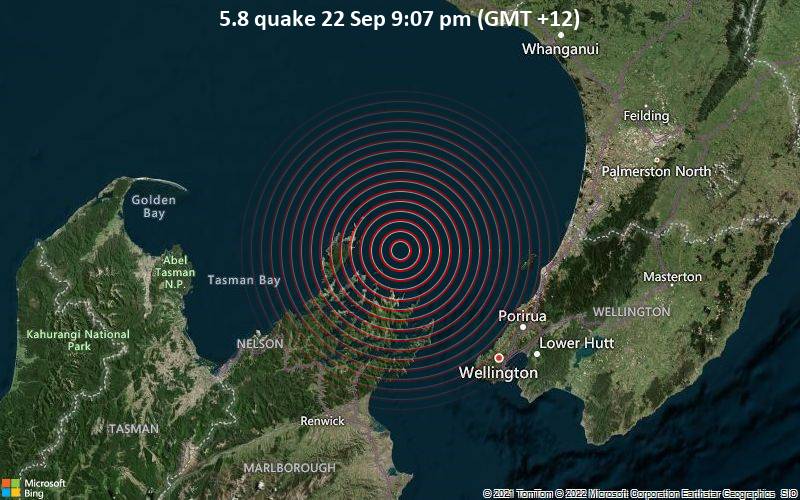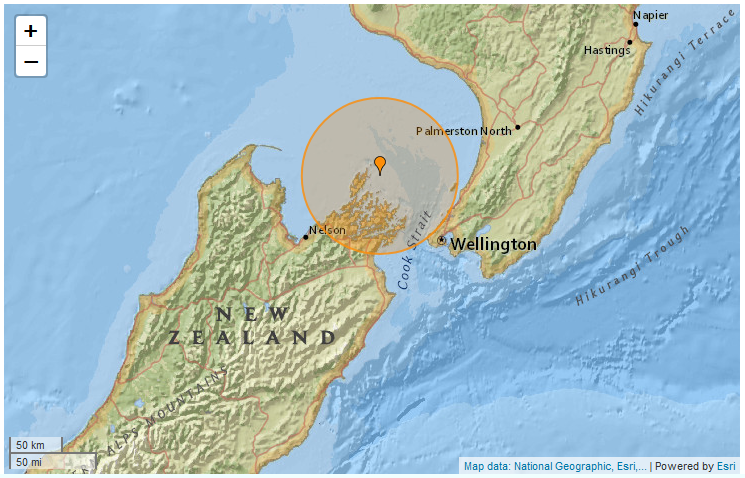Arcs of Glory: Nelson and Wellington
by Nathan Shaw
In September 2022 I was scheduled to speak at a meeting in Wellington. As I sought God about this meeting He showed me His plan to establish a strategic arc of glory between Nelson and Wellington. When I looked on the map I was surprised to find that Nelson and Wellington are almost on the same latitude. They both lie at the centre of New Zealand—Nelson at the top of the South Island, and Wellington at the bottom of the North Island.
Biblically an arc of glory is about relationship and spiritual government. In the holy of holies two cherubim sat on the ark of the covenant.1 The cherubim faced each other with extended wings. Their extended wings, and their relationship toward one another, formed an arc of glory, and a seat of government. This seat of government is also referred to as the mercy seat. Similar living imagery is found in Ezekiel 1 where Yahweh appeared on a living throne chariot—even the wheels of the chariot were alive! These images further prefigure God’s temple made of living stones (Ephesians 2:19-22, 1 Peter 2:5).
An arc of glory between two cities is established by strategic relationships. The relationships establish an arc of glory and a seat of government for God’s kingdom rule. Intercessors and churches form a strategic part of these relational arcs. It is often said, “One can put a thousand to flight, and two can put ten thousand to flight” (see Leviticus 26:8 and Deuteronomy 32:30). The same is true of cities. Each city has it’s own unique authority and destiny, however, strategic relationships between cities (and even nations) multiplies their spiritual authorities in dynamic ways.
Since 2014 God has shown me five strategic relationships that are to form an arc of glory. They are between:
- Dunedin and Christchurch.
- The South Island and the North Island.
- New Zealand and Jerusalem.
- New Zealand and Australia.
- Nelson and Wellington.
In each case the city or nation involved cannot reach its full destiny and authority without relationship with the other. The Nelson and Wellington relationship is significant because two of the earliest betrayals of the Treaty of Waitangi happened in those regions. Firstly, the Wairau Affray on the 17th of June 1843. Secondly, the Hutt Valley Campaign in 1846. Both of these armed conflicts were between indigenous Māori and European settlers over issues of land and sovereignty.
The September 22nd Earthquake
The meeting I had at Wellington was on September 23rd, 2022. On September 22nd at 9:07pm there was a 5.8 magnitude earthquake centred about 70km off-shore from the Kāpiti coast.2

It is incorrect to assume that God speaks through every earthquake, however in this instance I knew He was speaking to me. The first thing I noticed was that the epicentre of the earthquake was a similar distance from both Nelson and Wellington.3 By itself this may not seem significant. But the fact that the earthquake happened the night before I was going to speak about an arc of glory between Nelson and Wellington definitely got my attention.

Interestingly the epicentre of the earthquake was also a similar distance from the events of the Wairau Affray at Tuamarina and the Hutt Valley Campaign north of Wellington. It was some time after my visit to Wellington, however, that another detail caught my attention. The epicentre of the earthquake was at latitude 40.81 degrees south. On the mainland this latitude lies between two significant towns: Ōtaki and Waikanae. To understand the significance of these towns we will have to go back to the 1820s and 1830s.
Te Rauparaha
Te Rauparaha was the great Ngāti Toa chief who migrated his tribe south from Kāwhia, eventually setting up base on Kāpiti Island. In due course two other tribes joined them: Te Āti Awa of Taranaki, and Ngāti Raukawa, who were closely related to Ngāti Toa. The combined strength of these tribes caused them to dominate the southern North Island, and the northern South Island. Ngāti Toa settled at Porirua, Te Āti Awa at Waikanae, and Ngāti Raukawa at Ōtaki.
| Tribe | Village | Migrated From |
| Ngāti Raukawa | Ōtaki | Southern Waikato & Northern Taupō |
| Te Āti Awa | Waikanae | Taranaki |
| Ngāti Toa | Porirua | Kāwhia |
Christianity first came to the Kāpiti region by Māori slaves released from captivity after their masters became Christians. In October 1839, Te Rauparaha’s son, Tāmihana Te Rauparaha, and nephew, Mātene te Whiwhi, went by ship to the Paihia Mission Station in the Bay of Islands to request a missionary for their area. This was a courageous move for the two young men, there were real grievances between Ngāti Toa and Northland’s Ngāpuhi. Henry Williams, Jr, notes in a letter that they came at the hazard of their own lives (NB: this Henry shared the same name as his more well-known father).
Octavius Hadfield
In 1838, at 23 years of age, Octavius Hadfield left England for the New Zealand mission field. Much of his life had been plagued with a health issue that left him chronically weak for extended periods, and, at times, even close to death. Two years earlier he had written, “I made up my mind that if my health improved I would go to work somewhere as a missionary among the heathen...I was deeply impressed with the fact that after the lapse of eighteen centuries our Lord’s command at the close of His work (Matthew 18:19-20) had been very imperfectly obeyed. This strong impression seemed like a duty to me. I further felt that to have a strong conviction of a duty and not to act upon it must be morally wrong. September 11,1837, I wrote to the Church Missionary Society offering myself as a missionary and saying that I was prepared to go to any part of the world.”
Hadfield was at the Paihia Mission Station when Tāmihana and Mātene arrived requesting a missionary. Henry Williams, Jr, a 15 year old student of Hadfield’s at the Paihia mission school, describes what happened: “There being a difficulty as to who could be spared, Mr. Hadfield offered to go himself. My father [Henry Williams, Sr] was very much struck with his brave offer, and remarked, how was it possible for him to think of going in his delicate state of health: he replied that he could only die once, and would just as soon die in a Māori Pā as in a missionary’s house.” Hadfield made the journey with Henry Williams, Sr. His health was so delicate it was generally agreed he would die there. They arrived at Waikanae on November 18th, 1839.
Five weeks before Williams and Hadfield arrived there had been a battle between the Ngāti Raukawa of Ōtaki and the Te Āti Awa of Waikanae. The animosity between the two tribes was still simmering. Regardless, it was decided that Hadfield would divide his time between the two villages and a small dwelling was set up at each location. Despite Hadfield’s continuing and serious health issues this marked the beginning of 65 years of ministry in the lower North Island and upper South Island. Hadfield’s great granddaughter, Barbara MacMorran, writes of him, “Hadfield’s influence seems to have been considerable, especially in his earlier years, and his mana strong. In the weeks following the Wairau Massacre in 1843 he was credited as being largely responsible for preventing Te Rauparaha and his excited followers from sacking Wellington and its inhabitants, and three years later when the town was again in danger due to much unrest it was his presence there, even though as an invalid, that was widely held responsible for peace being kept in the town.”
Hadfield advocated strongly against the injustices experienced by Māori at the hands of settlers and the British Crown. He was both known, and at times hated, by many of the most prominent politicians of the time. Hadfield expressed his stance clearly when he wrote, “I marvel at the lukewarmness of people who profess to love justice and hate iniquity.” He wrote three short books, each published in England, exposing these injustices. The books were:
- One of England’s little wars (1860).
- A Sequel to “One of England’s little wars” (1861).
- The New Zealand war; the second year of one of England’s little wars (1861).
The Marlborough Press wrote of Hadfield after his death, “He was one of the most remarkable men the Colony has ever known, one to whom she owes more than the present generation are aware of” (December 14th, 1904). This statement is still true today. God is about to shine His light on some of the key players in our early history, including Te Rauparaha, Tāmihana Te Rauparaha, Mātene te Whiwhi, and Octavius Hadfield. Hadfield came to Kāpiti at the invitation of Tāmihana and Mātene. It was their invitation and Te Rauparaha’s acceptance of Hadfield that opened the door for the gospel to thrive in their region.
As already stated, the epicentre of the 5.8 magnitude earthquake on the 22nd of September 2022 had a latitude of 40.81 degrees south. On the mainland 40.81 degrees south lies between Ōtaki and Waikanae, the villages where Hadfield set up his two small dwellings.
| Location | Lattitude |
| Rangiātea Church, Ōtaki | 40.75°S |
| Epicentre of September 22nd, 2022 Earthquake | 40.81°S (between 40.78 and 40.84°S when allowing for the stated margin of error) |
| Kenakena Pa, Waikanae | 40.89°S |
Transforming a Nation
An integral part of establishing an arc of glory between Nelson and Wellington is understanding the invitation of Tāmihana Te Rauparaha and Mātene te Whiwhi, the response of Octavius Hadfield, the removal of dividing walls between tribes and peoples, and the righteous stand against any and every injustice. Interestingly the earthquake happened at 9:07pm. Isaiah 9:7 says: “Of the increase of His government and peace there will be no end, upon the throne of David and over His kingdom, to order it and establish it with judgment and justice from that time forward, even forever. The zeal of the Lord of hosts will perform this.” God is committed to establishing His justice, His way. Also of note is the earthquakes magnitude of 5.8. Isaiah 58 is a chapter about justice, freedom from oppression, covenant relationship and full restoration.
The sound of covenant over Aotearoa has become muddied and blurred by past betrayals and present agendas. A clear sound is coming forth that will call the nation to her ultimate destiny. The arc of glory between Nelson and Wellington is about restoring the heartbeat and glory of covenant to centre place. Once it is established it will give rise to dramatic manifestations of physical healing. It is a strategic arc that will unlock profound destiny over the nation.
References:
Further Reading:
Burton, Ormond, Hadfield of the Kapiti Coast, 1972
Ballara, Angela, Taua: Musket Wars, Land Wars or Tikanga? Warfare in Maori Society in the Early Nineteenth Century, Penguin 2003
Carkeek, Wakahuia, The Kapiti Coast: Maori History and Place Names, Reed 1966
Collins, Heni, Ka Mate Ka Ora!: The Spirit of Te Rauparaha, Steele Roberts 2010
Lethbridge, Christopher, The Wounded Lion, Caxton Press 1993
MacMorran, Barbara, Octavius Hadfield, 1971
Ramsden, Eric, Rangiatea: The Story of Otaki’s Maori Church Its First Pastor and Its People, Reed 1951
Te Rauparaha, Tamihana & Calman, Ross, He Pukapuka Tataku i Nga Mahi a Te Rauparaha Nui / A Record of the Life of the Great Te Rauparaha, Auckland University Press, 2020
Travers, W. T. L., The Stirring Times of Te Rauparaha, 1906
Related Articles:
Word for New Zealand – Nathan Shaw
The East Gate – Nathan Shaw
ANZUS, the East Gate, and the Alignment of the Nations – Nathan Shaw
Back to Words for Nations

